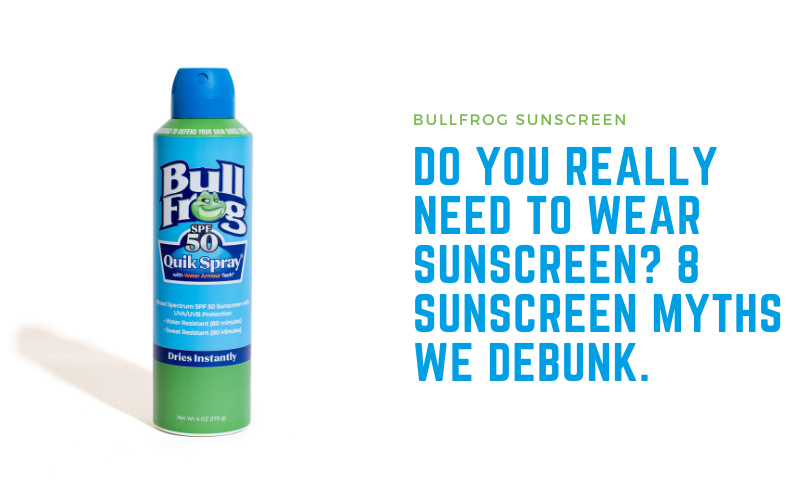
Are you ready to debunk some sunscreen myths? Sunscreen is one of the best preventative measures we have against everything from premature aging to skin cancer. However, there's still a lot of confusion swirling around about when you actually need to wear sunscreen. Let’s clear up eight dangerous sunscreen myths with some crucial facts about sunscreen.
Myth #1: I Don't Need Sunscreen on Cloudy Days
"Unless you are completely shaded and protected from the sun, you still need sunscreen on cloudy days,” according to Dr. Leventhal of Yale Medicine. That's because UV rays can penetrate clouds, and you don't necessarily need to feel the sun beating down on your skin to experience the effects of UV exposure. While it may be tempting to skip sunscreen on days of peek-a-boo sunshine, sun damage can occur with just short intervals of sun exposure.
Myth #2: I Only Need to Wear Sunscreen at Midday
You've probably heard that the sun's rays are strongest between roughly 10 a.m. and 3 p.m. This actually isn't a myth. While it's true that sun exposure peaks in the middle of the afternoon, there is a chance for sun damage during all daylight hours. A good rule to follow is to always wear sunscreen when spending any time outdoors between sunrise and sunset.
Myth #3: I'll Get a Vitamin D Deficiency From Wearing Sunscreen
Many people think they're making the healthy choice by skipping sunscreen as a way to get more vitamin D. There is some truth to the fact that sunscreen reduces vitamin D absorption when it blocks out UVB rays. However, it may be less of a concern than some people think. As the writers at Harvard Health point out, very few people actually put on enough sunscreen to block all UVB light. What's more, an Australian study looking at the relationship between sunscreen and vitamin D found no difference in vitamin D levels between adults using real sunscreen and a placebo.
Myth #4: I Don't Need Sunscreen in the Winter
Do I need to wear sunscreen in the winter? Many people believe that you can't get a sunburn in the winter. In reality, one of the most surprising facts about sunscreen is that temperature has nothing to do with the UV index. It's true that you can generally get away with skipping sunscreen on your body if you're bundled up in your winter gear. However, areas that are exposed will need to be covered in sunscreen if you'll be spending more than a few minutes outside in the winter. In fact, people who participate in skiing, snowboarding, and other outdoor winter sports are particularly vulnerable to wintertime sunburns due to sun glare. The sun's effects are magnified when they reflect off of snow. When skiing at high altitudes, it's important to remember that the sun's UV rays intensify by 8% to 10% for every 1,000 feet of elevation gained.
Myth #5: I Don't Need to Wear Sunscreen If My Makeup Has SPF Protection
Do I need to wear sunscreen if my makeup already has it? The SPF in some foundations can be great for staying protected from the sun when dashing in and out of the house on a typical day. However, it can't replace proper sunscreen. First, most of these products only offer bare-minimum SPF 15 protection. It's also nearly impossible to wear enough of these makeup products to get the sun protection advertised, and you need close to a teaspoon of product to get full coverage. Makeup in sunscreen should be considered a "bonus." If you're looking for more reliable sun coverage, place your SPF makeup over sunscreen. Applying sunscreen and makeup with SPF protection does not increase your SPF level beyond the highest SPF you're getting from either product. However, it can provide more protection over your whole face.
Myth #6: I Don't Need to Wear Sunscreen If I Have a Darker Skin Tone
This is one of the most dangerous sunscreen myths out there because it lures people into a false sense of security about sun damage. The truth is that everybody needs sunscreen. Many people believe that darker skin tones aren't at risk for skin cancer because of the myth that higher levels of melanin make the skin impervious to sunburns, skin cancer, and sun-related aging. The truth is that darker skin tones can often have a natural SPF level of up to 13. However, this isn't enough to protect the skin. Dermatologists generally recommend daily sun protection with at least SPF 30.
Myth #7: Applying Sunscreen Once a Day Is Enough
Are you good to go for the rest of the day after applying sunscreen? Unfortunately, this is another myth. All sunscreens break down as they absorb UV light, and it's best to reapply sunscreen every two to three hours when spending extended amounts of time outdoors. While waterproof sunscreens provide extra protection when sweating and swimming, it's still important to be diligent about reapplication. Many people unknowingly lose their sun protection after wiping away their sunscreen when drying off with a towel.
Myth #8: All Sunscreens Are the Same
One of the little-known facts about sunscreen is that most popular sunscreens contain oxybenzone, octinoxate, and other harmful chemicals. Chemicals in sunscreen have been known to cause everything from sickness to neurological effects. What's more, many are pollutants that contribute to the degradation of waterways and coral reefs. Most of us have grown up assuming that any big-name sunscreen product for sale on the shelf is safe. However, many ingredients that have been proven harmful to humans and the environment have yet to be banned. Do I need to wear sunscreen with harmful chemicals to stay protected from sun damage?

People seeking safe sunscreen for the whole family are switching to Bullfrog. Trusted by fishermen, hikers, and outdoors people for decades, Bullfrog is now the sunscreen parents trust for broad-spectrum moisturizing UVA/UVB protection without oxybenzone and octinoxate. Reef-safe Bullfrog is enriched with antioxidants and soothing plant extracts. You can count on long-lasting protection with sweat and water resistance in spray, gel, and lotion varieties. Beat sunscreen myths by choosing the Bullfrog formula that's right for your family today!
